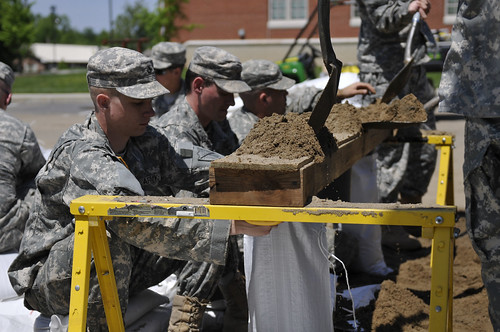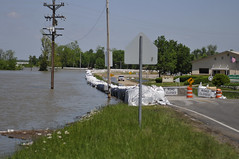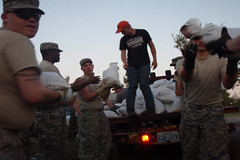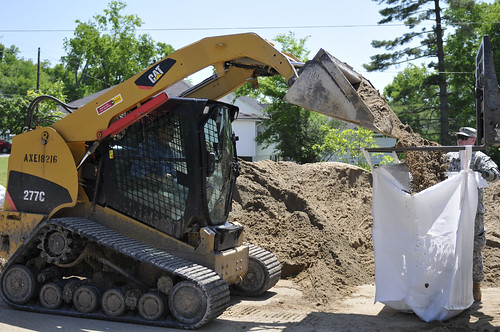dwa
[caption id="" align="aligncenter" width="500" caption="Soldiers of the Kentucky Army National Guard 's 1123rd Sapper Co. from Leitchfield, Ky., fill sandbags in Smithland, Ky. in support of flood relief efforts on May 4, 2011. Guardsmen are currently deployed to multiple locations across Western Kentucky. (U.S. Air Force photo by Tech. Sgt. Dennis Flora, Kentucky Air National Guard)"]

Click here for the latest photos of the Kentucky National Guard flood relief mission
FRANKFORT, Ky. (May 5, 2011) – Governor Steve Beshear announced that much of the lower Ohio River will crest today -- two weeks after Kentucky began experiencing a successive system of storms that caused flooding, tornadoes and straight line winds throughout much of the state. The Mississippi River is projected to crest on Saturday.
[caption id="" align="alignright" width="240" caption="A wall of sandbags holds back the Ohio river from the city of Smithland, Ky. Guardsmen are currently deployed to six counties across Western Kentucky in response to recent flooding. (U.S. Air Force photo by Tech. Sgt. Dennis Flora, Kentucky Air National Guard)"]

Gov. Beshear also reminded residents that Kentucky’s flood disaster declaration has been granted by President Obama. Requests for Public Assistance and Hazard Mitigation have been granted. All other requests are currently under review.
“The granting of federal assistance by the president will go a long way toward bringing relief to the citizens of the Commonwealth,” said Gov. Beshear. “The flood waters should begin to recede soon, and our families and businesses have a lot of recovery ahead of them. The federal disaster declaration is an appropriate and timely response to those needs.”
Also today, the Governor added another 16 counties to his original request for disaster assistance for farm families to Agriculture Secretary Tom Vilsack. Gov. Beshear had asked for disaster relief for 21 counties related to the storms that have damaged nearly every facet of the state’s agriculture industry.
[caption id="" align="alignleft" width="240" caption="Kentucky Army Guard members from the 118th Engineer Support Platoon - also known as the "Landshark Platoon" - offload sandbags to be used to keep water from the Ohio River away from homes in Tiline, Ky. (U.S. Army Photo by Spc. Mark Call, Kentucky National Guard Unit Public Affairs/Historian Representative)"]

The U.S. Army Corps of Engineers expects the Ohio River to crest in Paducah at 55.8 feet today, lower than the record of 60.6 feet set in 1937. The Ohio River will likely crest at 55 feet at the Smithland levee sometime today. The Corps expects the river to hold steady at crest level for about two days before beginning to recede.
Federal Emergency Management Agency (FEMA) representatives continue damage assessments throughout the state. The federal teams work alongside representatives from Kentucky Emergency Management (KYEM), small business administration and local emergency management. The joint assessment teams will assess all damages to infrastructure, businesses and homes in each county with a disaster declaration in order to calculate the magnitude of loss. The total assessments will help determine the level of federal disaster relief.
[caption id="" align="alignright" width="240" caption="Kentucky Army National Guard Sgt. Joshua Gill, 118th Engineer Support Platoon, places a sandbag to prevent rising water from the Cumberland River in Tiline, Kentucky. The 118th, based in Walton, was activated to help communities in western Kentucky affected by the waters of the flooded Ohio River. The small community of Tiline, which is just east of flooded Smithland, got help from the Soldiers of the "Landshark Platoon." (U.S. Army Photo by Spc. Mark Call, Kentucky National Guard Unit Public Affairs/Historian Representative)"]

More than 600 Kentucky National Guard troops continue to assist in flood relief efforts in six western Kentucky counties. Missions include security patrols, evacuation support, sandbagging operations, communications and logistics and aviation support.
Approximately 3,800 Kentucky residents have evacuated their homes since flooding began. Four Red Cross shelters housed 38 people last night in three locations; a total of five Red Cross shelters are operating statewide.
Engineers and emergency response teams are monitoring the Hickman and Smithland levees around the clock for signs of failure or breach.
Heavy rains on Monday and Tuesday in the central portion of the state produced one to four inches of rain, adding runoff to regional lakes and tributaries. The additional runoff may cause minor to moderate flooding in the Green River, Licking River, Rolling Fork River and Salt River. No additional evacuations are expected as a result of this recent rainfall.
Historic lake levels have been reported across the Commonwealth, and some controlled releases are underway at Lake Barkley and Kentucky Lake. Water has crested at the spillway at Taylorsville Lake, and provided there are no further storms, the water should begin to recede.
According to the Kentucky Transportation Cabinet (KYTC), approximately 250 roads are closed affecting more than 50 counties. Because of the rapidly changing nature of flooding, road closure information can quickly become outdated. Before traveling to an affected area, check with local authorities. Traffic information for interstates, parkways and major routes is available at 511.ky.gov or by calling 511. In addition, KYTC has a map on its website (www.transportation.ky.gov) indicating road closures.
[caption id="" align="alignleft" width="350" caption="Spc. Justin Doty guides two pieces of heavy machinery in filling a large sandbag in Smithland, Ky. in support of Western Kentucky flood relief efforts. Doty is part of the Kentucky National Guard's 1123rd Sapper Company from Leitchfield. (U.S. Air Force photo by Tech. Sgt. Dennis Flora, Kentucky Air National Guard)"]
 Flood Safety and Recovery Tips
Flood Safety and Recovery Tips
The Kentucky Department for Public Health (DPH) reminds Kentuckians to follow safety guidelines in the wake of severe flooding and water run-off throughout the state.
“We want Kentuckians to use caution as flood conditions remain in some areas, and as clean-up begins as floodwaters recede,” said Dr. William Hacker, DPH commissioner. “Taking the time to follow safety guidelines related to clean-up and mold removal can prevent unnecessary injury and illness.”
The following precautions are recommended by DPH:
* Use care during clean-up measures. Wear proper safety equipment, such as work gloves, boots, helmets, eye and ear protection, and chainsaw chaps when operating power tools or machinery. Ensure all electrical tools are properly grounded and use ground fault interrupters (GFI) if available. Never use electrically powered tools in or near standing water.
* Homeowners whose homes sustained water damage are urged to follow recommendations to limit mold growth. Mold fungi can be found indoors and outside and can accumulate in homes affected by flood/water damage. Mold grows best in warm, damp and humid conditions.
* Signs of mold include discolored walls or green or black spots apparent on walls. Mold also has a musty, earthy smell or a foul stench. Allergy sufferers tend to be most affected by mold exposure.
* If mold is growing in your home, you will need to clean up the mold and fix the moisture problem. Mold growth can be removed from hard surfaces with commercial products, soap and water, or a bleach solution of no more than 1 cup of bleach in 1 gallon of water. Severe mold cases may require an expert to clean up.
* DPH recommends opening doors and windows while cleaning the affected area. Use protective glasses or goggles, rubber boots and waterproof gloves and wash clothing afterwards.
* If there is heavy mold growth, use a respirator or suitable mask to prevent breathing the mold.
* Remove all items that have been wet for more than 48 hours and are not able to be cleaned and dried.
For more information about public health issues related to flooding, visit the Health Alerts website <
http://www.healthalerts.ky.gov/> or the Centers for Disease Control and Prevention (CDC) website <
http://www.bt.cdc.gov/disasters/floods/> .
###